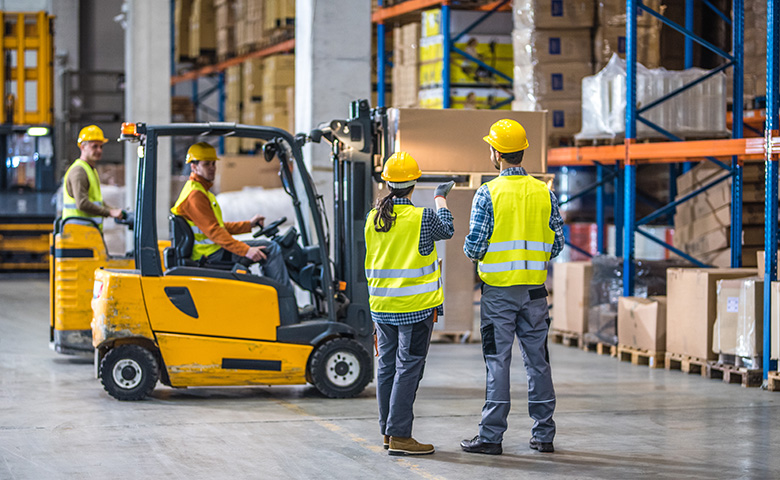Forklifts protect workers from the back-breaking work of lifting and moving extremely heavy objects, but they are also a hazard themselves and can result in serious workplace incidents. Weighing up to 9,000 pounds and capable of reaching speeds of up to 18 mph, forklifts should be operated with care and respected for the dangers they pose.
OSHA estimates that forklift-related workplace incidents account for approximately 85 deaths and 35,000 serious injuries per year. Basic training and compliance with industry safety standards are essential, but should also be viewed as a starting point for your workplace forklift program. In addition to legal requirements, consider the following five ways to bolster and improve forklift safety in your workplace.
Rotating safety posters
Safety posters are a great way to remind forklift operators (and staff who work in the same areas as forklifts) of safety rules and potential risks. Supervisors should deliver consistent messaging in concert with the posters so that workers receive daily reminders to be on guard and stay alert. Safety posters should be displayed in high-traffic areas where workers are most likely to see them, such as break rooms and common spaces.
Keep in mind that posters are only effective when workers actually read them. Simply putting them up and letting them gather dust quickly renders them useless. Be sure to rotate the posters throughout the workplace and even swap out for similar posters with equivalent messaging every so often to help keep the posters more visible to your workforce.
A Forklift Hand Signals poster is also recommended, as is corresponding training to make sure workers understand them. Supervisors should remind operators to always use hand signals during operation as they increase workplace safety. Hand signals take the guesswork out of working alongside forklifts, clearly communicating to everyone what the operator is doing—and safety posters are a great way to remind everyone about the importance of forklift hand signals.
Toolbox talks
Encourage the use of toolbox talks or short safety meetings to keep forklift safety fresh in the minds of your staff. Schedule the talks regularly and rotate the topics to keep them engaging. Conversations should be encouraged in these short meetings, as the sharing of personal stories involving forklift incidents can raise interest levels and inspire participation. Common hazards to highlight during these talks include blind spots for forklift drivers, and taking into account the building columns, narrow aisles and intersections in warehouses when operating a forklift and determining turning radius. Demonstrations are also a great way to get messaging through to staff and get safety training to stick.
Human factors training
A forklift operator who is tired, distracted or in a rush while working can exponentially raise the chance of an incident in your workplace. Operators should be trained on how to recognize and guard against these and other human factors. Forklift operation can be monotonous work, often requiring long shifts of repetitive actions, and can result in the drifting of attention and loss of focus. Human factors training helps staff to recognize when human factors are impacting them and to take steps to reduce the likelihood of an incident or injury.
Safety managers and supervisors also need to take steps to prevent the negative effects of human factors in the workplace. Frequent breaks are highly recommended. Supervisors should ensure forklift operators are taking their breaks and not working through them. Regular and direct communication with workers is also recommended. Conversations can sometimes reveal a worker to be over-tired or frustrated, for example, and the supervisor can make sure they don’t begin operating the forklift until the worker regains their composure.
Safe driving practices
As workers gain experience, their comfort level with driving and operating the forklift grows, which in turn leads to increased complacency. Without intervention, this can lead to elevated risks of forklift incidents. A great way to reduce forklift crashes struck-by incidents and other safety issues, and to guard against complacency, is to continually provide operators with refreshers on safe driving practices. In particular, distracted driving is something to key in on, especially for experienced and comfortable drivers.
Supervisors should ensure that vehicles are kept free of any potential distractions: no phones, food or drink, or personal items should be kept or used in the forklift. Supervisors should provide ample and secure space for operators to put their belongings, schedule frequent breaks, and do spot checks on the forklifts before and after use to ensure compliance.
You may also want to consider making distracted driving a regular topic during toolbox talks. Share personal stories of incidents or close calls related to distracted or unsafe driving practices to make the topic relatable and not simply a list of warnings and rules. Explain that the benefits of safe driving practices extend outside the workplace to their own personal vehicles. Having a cautious and defensive approach while driving might save your workers from an incident whether they are in the stacks or on the highway.
Clear communication, strong leadership and active participation are the tenants of a strong forklift safety program and will minimize the number of incidents in your workplace. According to OSHA, 70% of forklift incidents could be prevented through more strict and robust training and health and safety programs. It could also reduce damage and other incidents that don’t cause injury but that are costly nonetheless.
Invest in your supervisors by giving them the communication skills and knowledge to ensure all necessary forklift safety protocols are practiced in your workplace. Supervisors who are trained in communicating to workers in both structured group settings and informal one-on-one situations can be very effective in promoting safety first in the workplace. They can help integrate these four simple strategies and improve the forklift safety program in your workplace.

